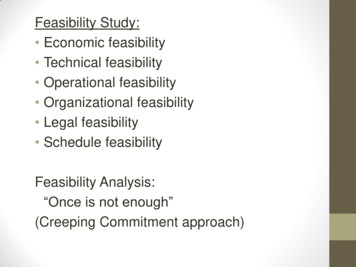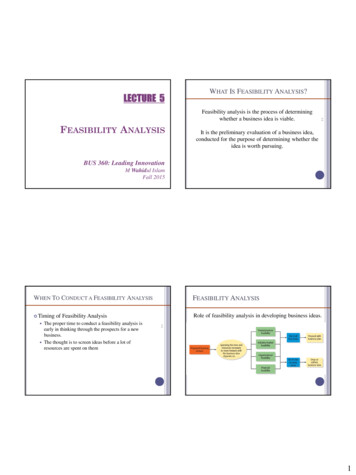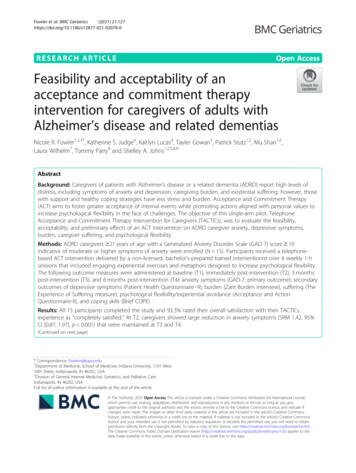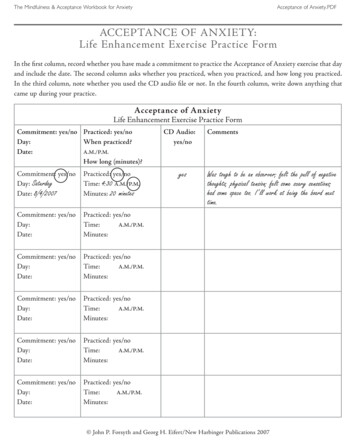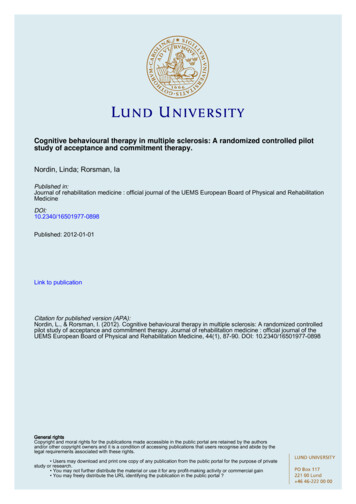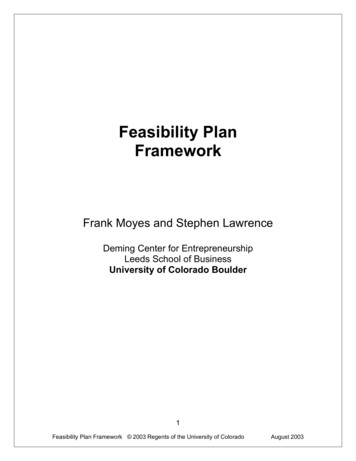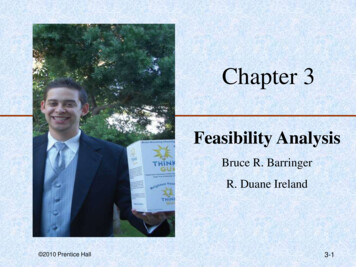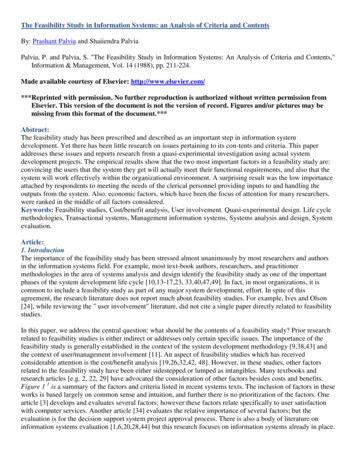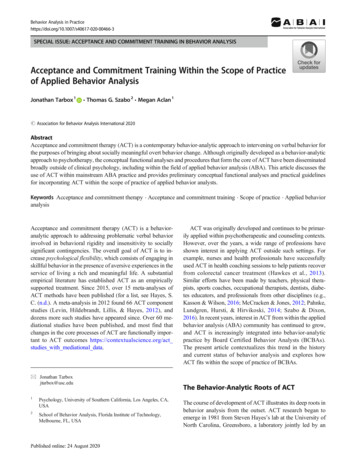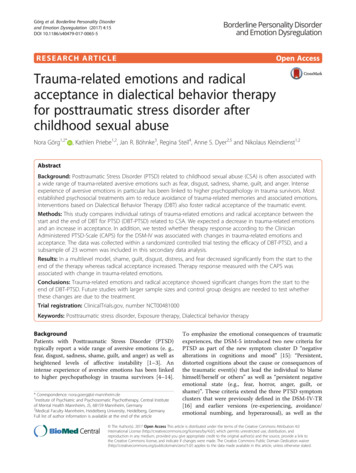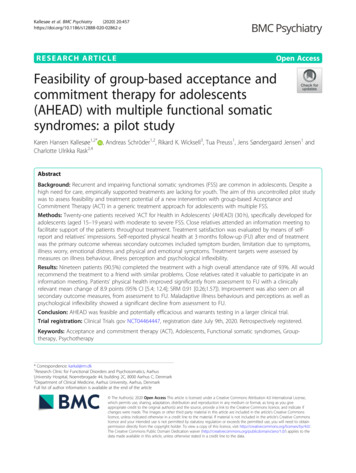
Transcription
Kallesøe et al. BMC Psychiatry(2020) SEARCH ARTICLEOpen AccessFeasibility of group-based acceptance andcommitment therapy for adolescents(AHEAD) with multiple functional somaticsyndromes: a pilot studyKaren Hansen Kallesøe1,2* , Andreas Schröder1,2, Rikard K. Wicksell3, Tua Preuss1, Jens Søndergaard Jensen1 andCharlotte Ulrikka Rask2,4AbstractBackground: Recurrent and impairing functional somatic syndromes (FSS) are common in adolescents. Despite ahigh need for care, empirically supported treatments are lacking for youth. The aim of this uncontrolled pilot studywas to assess feasibility and treatment potential of a new intervention with group-based Acceptance andCommitment Therapy (ACT) in a generic treatment approach for adolescents with multiple FSS.Methods: Twenty-one patients received ‘ACT for Health in Adolescents’ (AHEAD) (30 h), specifically developed foradolescents (aged 15–19 years) with moderate to severe FSS. Close relatives attended an information meeting tofacilitate support of the patients throughout treatment. Treatment satisfaction was evaluated by means of selfreport and relatives’ impressions. Self-reported physical health at 3 months follow-up (FU) after end of treatmentwas the primary outcome whereas secondary outcomes included symptom burden, limitation due to symptoms,illness worry, emotional distress and physical and emotional symptoms. Treatment targets were assessed bymeasures on illness behaviour, illness perception and psychological inflexibility.Results: Nineteen patients (90.5%) completed the treatment with a high overall attendance rate of 93%. All wouldrecommend the treatment to a friend with similar problems. Close relatives rated it valuable to participate in aninformation meeting. Patients’ physical health improved significantly from assessment to FU with a clinicallyrelevant mean change of 8.9 points (95% CI [5.4; 12.4]; SRM 0.91 [0.26;1.57]). Improvement was also seen on allsecondary outcome measures, from assessment to FU. Maladaptive illness behaviours and perceptions as well aspsychological inflexibility showed a significant decline from assessment to FU.Conclusion: AHEAD was feasible and potentially efficacious and warrants testing in a larger clinical trial.Trial registration: Clinical Trials gov NCT04464447, registration date July 9th, 2020. Retrospectively registered.Keywords: Acceptance and commitment therapy (ACT), Adolescents, Functional somatic syndromes, Grouptherapy, Psychotherapy* Correspondence: karkal@rm.dk1Research Clinic for Functional Disorders and Psychosomatics, AarhusUniversity Hospital, Noerrebrogade 44, building 2C, 8000 Aarhus C, Denmark2Department of Clinical Medicine, Aarhus University, Aarhus, DenmarkFull list of author information is available at the end of the article The Author(s). 2020 Open Access This article is licensed under a Creative Commons Attribution 4.0 International License,which permits use, sharing, adaptation, distribution and reproduction in any medium or format, as long as you giveappropriate credit to the original author(s) and the source, provide a link to the Creative Commons licence, and indicate ifchanges were made. The images or other third party material in this article are included in the article's Creative Commonslicence, unless indicated otherwise in a credit line to the material. If material is not included in the article's Creative Commonslicence and your intended use is not permitted by statutory regulation or exceeds the permitted use, you will need to obtainpermission directly from the copyright holder. To view a copy of this licence, visit http://creativecommons.org/licenses/by/4.0/.The Creative Commons Public Domain Dedication waiver ) applies to thedata made available in this article, unless otherwise stated in a credit line to the data.
Kallesøe et al. BMC Psychiatry(2020) 20:457BackgroundAn increasing number of adolescents report daily unspecific physical symptoms [1]. While the symptoms areself-limiting in most cases, approximately 5–10% reportpersistent symptoms, and may receive diagnoses of functional somatic syndromes (FSS) [2]. FSS collectively referto a range of syndromes (e.g. chronic fatigue syndrome,idiopathic pain syndrome, juvenile fibromyalgia andfunctional gastrointestinal disorders (FGID)), characterized by a pattern of impairing physical symptoms forwhich no well-defined physical disease can be identified.Often comorbid anxiety and depression exist [3–5].The aetiology of FSS is assumed complex with interacting biological, psychological and environmental factors [2,6–8]. Suffering from FSS during adolescence can have serious consequences in terms of school absence, social withdrawal and reduced quality of life [2]. Frequently,symptoms sustain into adulthood, carrying a significantrisk of long-term impairment, reduced probability ofobtaining a higher education and a high use of health carecosts [9–13]. Known maintaining factors include negativeillness perceptions (e.g. single cause attribution of symptom, no sense of control and long expectancy of symptoms) [14–16] and maladaptive illness behaviours (e.g.avoidance, control and ‘all-or-nothing’ behaviour) [17].Furthermore, parental overprotective behaviour can increase distress and disability in the young [18–21], andbetter outcome is suggested when parents support a shiftfor more accommodative coping styles [22, 23].Recent reviews show that psychological interventions,particularly based on cognitive behavioural therapy(CBT) principles, are effective for FSS in children andadolescents in reducing symptom load, disability andschool absence [24, 25]. Acceptance and commitmenttherapy (ACT) is a newer development within CBT thathas shown promising results in children and adolescentswith chronic pain [26–28] and in adults with variousFSS [28–31]. The overall aim of ACT is to change howthe individual reacts to unwanted inner experiences bybroadening the behavioural repertoire, to facilitate moreadaptive strategies. This is done within the contextualframework of increasing ‘psychological flexibility’, i.e. theability to take actions in accordance with own life valuesalso in the presence of unpleasant physical and emotionalexperiences [32]. Psychological flexibility is increased bythe training of six core processes (i.e. acceptance, cognitivedefusion, being present in the moment, self as context,values and committed action). Hence, the overall focus inACT is to improve functioning by a shift in focus from alleviation of symptoms to acceptance of inner experiencesand commitment to engaging in values-based behaviours.Hereby ACT targets inefficient coping strategies such assymptom avoidance and control behaviour [33–35]. Furthermore, as complete symptom elimination may not bePage 2 of 16realistic in youth with multiple FSS, the strong focus onvalues may serve as a motivational factor for behaviouralchange [36].In adults with multiple FSS, a generic group-based treatment approach has been found effective regardless ofmain symptom [37]. The clinical rationale for a generictreatment approach is further supported by the empirically proved overlap in symptomatology between patientswith various FSS [38, 39]. Despite high co-occurrence ofsymptoms from different organ systems is also describedin youth [40, 41], research has so far focused on treatmentof single syndrome FSS based on sub-specialties in thepaediatric setting [24]. Hitherto one pilot study presentsdata on a generic treatment across symptom profiles in anadolescent population [42]. Further research on generictreatment options has been suggested to diminish the riskof fragmented care in specialized clinics [24, 43–45].Therefore, in this pilot study we evaluated a new genericACT-based group treatment for adolescents with multipleFSS, conceptualized under the unifying diagnostic category of multi-organ Bodily Distress Syndrome (BDS)[46]. The use of BDS as a diagnostic conceptualization forfunctional disorders is in line with the recommendationsby Burton et al. [47].Our main aim of the present study was to explore thefeasibility of a group-based ACT intervention for adolescents with multiple FSS, i.e. treatment adherence, satisfaction and overall experience with the treatmentreported by patients and close relatives. Furthermore, wewanted to explore preliminary efficacy testing andchanges in suggested treatment targets, i.e. illness perception, illness behaviour and psychological inflexibilitypertaining to the total intervention (i.e. assessment, psychoeducation, and group-based treatment).MethodDesign and settingThis was an open pilot trial. Enrolment started in May2013, and data collection was finalised in April 2015.Young patients were referred from general practitioners,hospital departments or medical specialists to a specialized university hospital service, for assessment and treatment of debilitating FSS.Trial registrationBefore commencement, the trial was registered at theDanish Data Protection Agency (no. 1–16–02-261-14)whereas the National Committee on Health ResearchEthics, Denmark waived registration (contact no. 93/2013) due to the feasibility nature of the study. The trialwas retrospectively registered at Clinical Trials GovNCT04464447.
Kallesøe et al. BMC Psychiatry(2020) 20:457Eligibility criteriaEligibility criteria were age 15–19 years, multi-organBDS, i.e. at least three functional somatic symptomsfrom at least three symptom groups, moderate to severeimpairment in daily life and symptom duration of minimum 12 months (see Table 1) [46, 48].ProceduresClinical assessmentReferrals were screened for eligibility by a physician(CUR). Eligible patients were invited for a standardizedclinical psychiatric and somatic assessment which wasperformed by physicians trained in child and adolescentpsychiatry (KHK and CUR). It consisted of 1) a systematicmedical and psychosocial history taking (see Additional file 1), 2) a semi-structured diagnostic interviewwith Schedules for Clinical Assessment in Neuropsychiatry (SCAN) which screens for general psychopathology(e.g. depression and anxiety) and contains a detailed section with evaluation of 76 functional somatic symptoms[49] and 3) a clinical/neurological examination followedby feedback on the result of the assessment with a shortpsychoeducation regarding the BDS diagnosis (see below).Impairment was rated by the physician as part of theSCAN interview based on reported degree of symptomrelated distress, school absence and social withdrawalfrom friends and leisure activities. The rating could beeither mild, moderate, or severe (e.g. severe would correspond to a high degree of school absence or droppedout of school, social isolation with withdrawal fromfriends and cessation of previous leisure activities).Participation in the study was voluntary. Patients andtheir parents (for patients younger than 18 years) wereTable 1 In- and exclusion criteriaInclusion criteria1. Bodily Distress Syndrome, multi-organ type of at least 12 months’duration.2. 15–19 years old at referral.3. Raised since early childhood in Denmark or born by Danishparents. Understand, speak and read Danish.4. Moderate or severe impairment.Exclusion criteria1. Acute psychiatric disorder demanding other treatment, or if thepatient is suicidal.2. A lifetime diagnosis of psychosis, mania or depression withpsychotic symptoms (ICD-10: F20–29, F30–31, F32.2, F33.3), seriouscognitive deficits or developmental disorders such as mentalretardation and autism (ICD-10: F70, F84)3. Substance abuse of e.g. narcotics, alcohol or medication.4. Pregnancy at the time of inclusion.5. Not able to participate in group-based treatment, e.g. patients withsevere ADHD (ICD-10: F90), severe social phobia (ICD-10: F40.1) orconduct disorder (ICD-10: F91).Page 3 of 16informed about the feasibility nature of the study. Patients were included after informed consent.PsychoeducationThe bio-psycho-social model including the potential roleof central sensitization and peripherally increased bodilystress response was used in an overall explanation of thedevelopment and maintenance of BDS [50–52]. Thisserved as a framework for an individualized case formulation based on the patients’ history with identificationof potential maladaptive coping strategies.Approximately 2 weeks after clinical assessment, thepatient and his/her parents attended a psychiatric consultation of 1½ hours, focusing on further psychoeducation and general advice on health promoting strategiesregarding sleep, eating habits, physical and social activities and engagement in positive activities (see Additional file 2). Potential present life stressors (e.g. familyconflicts, bullying, economic difficulties in the family)were evaluated to clarify areas where the patient or family might need additional help from other sectors. Maladaptive illness perceptions and behaviours, such asavoidance, control and ‘all-or-nothing’ behaviour, wereintroduced in general terms and addressed more specifically based on the case formulation if relevant. Finally,the patient chose two focus areas to work on until groupstart, e.g. change of eating habits or starting gradedexercise.Group-based ACT treatmentThe treatment: ‘ACT for Health in Adolescents’ (AHEAD) was an ACT-based group intervention consisting of 9modules (27 h in total) delivered over a period of 3months, with a follow-up meeting (3 h) 3 months afterthe last module (Fig. 1). Six to eight patients were included in each treatment group. An information meeting(3 h) for close relatives selected by the individual patient(i.e. primarily parents but could also include adolescentsiblings or a boyfriend) was held at the beginning of thegroup treatment, and the adolescent and the parentswere invited to a 1½-hour individual consultation afterthe 8th module. Two therapists who also developed thetreatment manual for AHEAD (CUR and TP), conjointlyperformed the treatment. The main therapist (a childand adolescent psychiatrist (CUR)) had classical CBTtraining and additional training in ACT and the cotherapist (a psychologist (TP)) had MBSR training andadditional training in ACT outside the trial and boththerapists had extensive knowledge of functionaldisorders.The following contains a description of the final content of the treatment (see overview in Fig. 1) after minorad hoc modifications as described in the result section.
Kallesøe et al. BMC Psychiatry(2020) 20:457Page 4 of 16Fig. 1 Timeline and final outline of group-based treatmentEvery treatment module was manualized. The overallaim was to support the adolescents to shift behaviourfrom symptom-related control and avoidance to valuesbased actions also when aversive symptoms are presenti.e. increase psychological flexibility.Thus, psychological inflexibility [32] was targeted bytraining the patients’ skills to open up to unwantednegative experiences (i.e. acceptance and defusion), being present in the moment, and acting in accordancewith life values [53]. These skills were trained in arange of exercises during the treatment modules andsupplemented by home assignments between eachmodule.In short, life values can be defined as freely chosen activities or constructs that give our life meaning and direction [54]. Some of the adolescents reported that theyhad never identified their life values and others described having lost contact with them. It was therefore aprocess throughout treatment to identify or re-connectwith values and to take small steps in valued directions.From module 3 and onwards, each module contained asession focusing on individual graded values-based exposure i.e. identifying behavioural steps and how to takethem.Opening up was addressed using metaphors and exercises aimed at improving the ability to allow for the
Kallesøe et al. BMC Psychiatry(2020) 20:457unpleasant bodily sensations without taking actions toavoid it (i.e. acceptance), in the service of remainingpresent in the moment. This also includes the capabilityof observing your thoughts, and seeing them as merelythoughts, rather than acting on them as if they representthe truth (i.e. defusion).Similarly, being present in the moment is a behaviouralskill that implies noticing and accepting the potentiallyintrusive thoughts and feelings. Thus, the treatment consisted of exercises to be conducted in session as well asbetween sessions, to improve the ability to redirect attention towards the present moment.In ACT, metaphors are often used to facilitate communication regarding e.g. exposure and acceptance topreviously avoided situations and reactions that may appear counter intuitive. For example, “monsters on thebus” is a metaphor used to conceptualize the negativethoughts and sensations that may occur and influencethe behaviours in challenging situations when the patientis taking actions in a valued direction. The monstersrepresent thoughts such as “you have too many symptoms”, “you are not strong enough” that function toavoid risks. The patient is driving his/her bus throughlife, and choose the direction (i.e. life values) but alsohave to decide whether or not to listen to the passengers(acceptance) when doing so may lead away from the valued direction.Throughout treatment, the term “helpers” was used tofacilitate the adolescents’ motivation for training the newadaptive strategies described above.The information meeting for close relatives containedthree main elements: 1. Further psychoeducation onBDS, 2. Exchange of experiences regarding being a family with or close relative to an adolescent with BDS and3. Information on treatment content, including ACT asa treatment approach, and the need for the relatives’ andfamilies’ support during treatment.A visit of a former patient was included in module 1and a visit of a former patient and a parent were includedat the information meeting for close relatives to informthe new participants about the patient perspective on thetreatment process and create hope and motivation forchange. This specific content was introduced in pilotgroup 3 and was not included in pilot-group 1 and 2.Page 5 of 16As part of the feasibility evaluation, we examined theutility of different questionnaires to assess the definedtreatment targets as well as the overall respondent burden. This meant that not all questionnaires were answered by all patients at all time-points (see Additionalfile 3 for details).Measures of treatment satisfactionPatients’ satisfaction with treatment was measured by 17items from a modified version of The Experience of Service Questionnaire (ESQ) [55] with additional questionsregarding specific treatment elements and open-endquestions. The questionnaire was distributed at thefollow-up meeting.Close relatives’ satisfaction with the information meeting was evaluated directly after the meeting by questionsconcerning specific meeting content e.g. “Is the meetingcontent relevant” (regarding: 1. what is BDS, 2. treatment principles, 3. being a family to an adolescent withBDS) and “Are the incorporated exercises in the meetingmeaningful” (regarding: 1. Presentation exercise, 2. Attention focused exercise, 3. Values-based exercise) (seeAdditional file 4). Also, there was a possibility of addingfree text comments.Primary outcome measureThe primary outcome was the aggregate score ‘physicalhealth’ derived from The 36-Item Short Form HealthSurvey (SF-36) subscales PF (physical functioning), BP(bodily pain) and VT (vitality) which all have shown tobe valid outcome measures in adult patients with severeFSS [56]. Thus, these three subscales have in adultsshown to be sensitive to change in key areas affected inFSS and was therefore chosen as a primary outcome[57–59]. The aggregate score has previously been usedin an RCT with group-based CBT for adults with multiple FSS, i.e. multi-organ BDS [37]. Scores range from15 to 65 with higher scores indicating better selfperceived physical health. A change of 4 and above isregarded as a clinically relevant change [60–62]. Genderand age-specific Danish norm data are available fromage 16 and up [63].Secondary outcome measuresMeasuresSelf-reported questionnaires were distributed before assessment, before the psychiatric consultation, beforegroup therapy, after 4th and 8th module of therapy (1and 2 months after treatment start, respectively), after9th module (i.e. end of treatment (EOT) 3 months aftertreatment start) and after 10th module, i.e. 3-monthfollow-up (FU). The latter was defined as the primaryendpoint.Symptom severity was measured by the BDS Checklist[64, 65] (25 items, 5-point scale), which evaluates symptoms from four symptom groups, i.e. musculoskeletal,gastro-intestinal, cardio-pulmonary and general symptoms. The sum score ranges from 0 to 100 with higherscores indicating higher symptom load. The questionnaire has shown acceptable validity [64]. A recentGerman validation study with inclusion of adolescentsshowed excellent psychometric properties and a
Kallesøe et al. BMC Psychiatry(2020) 20:457sufficiently high internal consistency of all four subscalesand the total score (all α 0.83) [65].Symptom impact was evaluated with the limitationindex (LI). LI is a modified version of the Pain Interference Index (PII) (6 items, 7-point scale) [66], a validatedquestionnaire for children and adolescents measuringthe impact of pain in performing everyday activities andimpact on mood and sleep. The modification from PIIto LI concerns a change in wording from ‘pain’ to ‘symptoms’. The sum score ranges from 0 to 36 with higherscores indicating a higher degree of limitation. The questionnaire has shown a high level of internal consistency(α 0.86) in a sample of children and adolescents withchronic pain [66].Illness worry was measured by Whiteley-7 [67] (7items, 5-point scale), a subscale of the Whiteley Index. Anoverall mean item score ranges from 0 to 4 with higherscores indicating more severe symptoms of illness worry.Whiteley-7 has shown acceptable psychometric propertiesin primary care [68], and good sensitivity and specificity inscreening for DSM-IV hypochondriasis [69].Emotional distress was measured by SCL-8, a subscalefrom Symptom Checklist Revised-90 [70–73] (8 items intotal, 5-point scale). An overall mean item score rangesfrom 0 to 4 with higher scores indicating a higher degreeof emotional distress.The overall impression of change was measured withPatient Global Impression of Change (PGIC) [74] (1item, 7-point scale). Answers range from “no change (orcondition has gotten worse)” to “a great deal better anda considerable improvement that has made all thedifference”.Page 6 of 160.89 (limiting behaviour) in adult patients post infectionand results suggested it to be a valid and reliable measure to predict the development of a functional disorderafter acute infection [77].Psychological inflexibility (two components, i.e. cognitive fusion and experiential avoidance) was measured bythe brief version of Avoidance and Fusion Questionnairein Youth (AFQ-Y8) [78] (8 items, 5-point scale). Thetotal score ranges from 0 to 32 with higher scoresreflecting a higher degree of avoidance and fusion. Recent studies show that AFQ-Y8 is a reliable and validmeasure of these elements of psychological inflexibilityin children and adolescents [79, 80].Statistical analysisData on feasibility (adherence, follow-up rates, and patient/parent satisfaction) were described by percentages.Data on primary and secondary outcomes as well astreatment targets were analysed using an unadjustedmixed model (one model for each of the abovementioned outcome measures) with time as the only(fixed effect) covariate and a random intercept. Usingthis model, we calculated the mean change from assessment to follow up (FU) as well as the mean change fromtreatment start to FU. All available data from all participants (including two patients who discontinued participation) were included in the analysis, and the modelswere checked by graphical inspection of the distributionof the residuals and random intercepts. Analyses wereperformed using Stata version 15.1 for Windows.ResultsMeasures of treatment targetsPatient characteristicsIllness perception was measured by the Brief Illness Perceptions Questionnaire (BIPQ) [75] (8 items, 0 to 10point scale and an additional item regarding cause ofsymptoms). It evaluates the perception of five core components (identity, cause, timeline, consequences, andcure-control) which together form the perception of illness. Score ranges from 0 to 80 with higher scorereflecting a more threatening view of the illness. A review and meta-analysis of the BIPQ has shown goodpsychometric properties across a range of populationsand age-groups and has demonstrated sensitivity tochange after intervention in randomised trials [76].Illness-related behaviour was measured by the Behavioural Responses to Illness Questionnaire (BRIQ) [77](13 item, 5-point scale). The questionnaire measures twodimensions of illness behaviour; (1) all-or-nothing behaviour (score range 6–30) and (2) limiting behaviour(excessive rest) (score range 7–35) with higher scores indicating a higher degree of maladaptive behaviour. Cronbach’s alphas were 0.81 (all-or-nothing behaviour) andA total of 54 consecutively referred adolescents werescreened for eligibility; 16 did not fulfil study criteria, 6were referred from another region (organizational rule,rejecting patients from other specific regions) and 1 didnot consent to referral (Fig. 2). Thus, 29 participated inclinical assessment where 21 patients met inclusion criteria and were included. All participants were girls. Fourpatients who at referral had just turned 20 years wereseen in the adolescent unit to increase inclusion rates inthe pilot study. The mean age at inclusion was 18.5(range 16.0–20.5) and mean duration of symptoms was4.25 years (range 1.4–13.0) (Table 2).At assessment, the most prevalent patient rated predominant symptoms were abdominal pain (19.1%), tension type headache (19.1%) and backache (14.3%). Thepatients were moderately to severely impaired due tosymptoms, e.g. high degree of school absence or droppedout of school, withdrawal from friends or stopped participating in previous leisure activities. Complete baseline characteristics are presented in Table 2.
Kallesøe et al. BMC Psychiatry(2020) 20:457Page 7 of 16Fig. 2 Participants’ flow through the studyFeasibilityFeasibility evaluation pertained to the group interventionand included treatment adherence and satisfaction andmodifications of treatment content and format based onevaluations.several comments addressing the positive fellowship ofthe group setting (e.g. “it was really good to meet andtalk to others who know the daily life with BDS”, “thefellowship of the group was really good” and “we workedwell together in the group which made the atmosphererelaxed – so I felt safe”.Adherence to group treatmentA total of three groups received treatment with 7, 8 and6 patients in groups 1, 2 and 3, respectively. Two patients dropped out of therapy after the first module, onefrom pilot group 1 and one from pilot group 2. Both patients were ambivalent about the group format beforestarting therapy. Of the remaining 19 patients, the overall attendance rate was 93% with 9 patients attending allmodules (i.e. 9 modules), 9 patients missing one moduleand 1 patient missing 3 modules.Satisfaction with group treatmentApart from the need for more handout material, the adolescents had positive responses regarding the grouptreatment (Fig. 3). An open-end question regarding theexperience of attending group therapy gave rise toFeedback close relativesA total of 43 (mainly parents (n 30) but also adolescentsiblings (n 4), boyfriends (n 4) and others (e.g. grandparents, close friends n 5)) filled out the questionnairedistributed at the information meeting for close relativesand provided overall positive feedback regarding thecontent of the information meeting (Fig. 4). Free textcomments included “it was really important to hear thestories from the other families – it made me feel that weare not alone”, “it’s important to be involved in theprocess” and “great balance between knowledge, dialogue, exercises and theory”.In the third pilot group, the visit from a former patientand a close relative was evaluated. Out of 22 answers,77% rated this as very valuable, 9% rated it valuable and
Kallesøe et al. BMC Psychiatry(2020) 20:457Page 8 of 16Table 2 Patient characteristics (N 21)Modifications to group treatmentMean (range)or n (%)Gender (female)Age, yearsaIllness duration, yearsa21 (100%)18.5 (16.0–20.5)4.25 (1.4–13.0)Impairment:Moderate6 (28.6%)Severe14 (66.7%)Family status:Parents divorcedComorbidity (medical)b:12 (57.1%)8 (38.1%) Migraine3 (14.3%) Asthma2 (9.5%) Allergic rhinitis4 (19.0%) Atopical dermatitis2 (9.5%) Gallstone1 (4.8%)Comorbidity (psychiatric)b:7 (33.3%) Hypochondriasis3 (14.3%) Social phobia2 (9.5%) Specific (isolated) phobia1 (4.8%) Major depressive disorder, single episode, mild1 (4.8%) Specific reading disorder1 (4.8%)Syndrome diagnosesc:Tension-type headache21 (100%)Non-cardiac chest pain18 (85.7%)Chronic fatigue syndrome (CFS)13 (61.9%)Fibromyalgia13 (61.9%)Irritable bowel syndrome (IBS)d8 (38.1%)Health-related quality of life: mean (SD)Physical health (aggregate score) (SF-36)34.4 (7.5)Physical component summary (SF-36 PCS)35.5 (8.6)Mental component summary (SF-36 MCS)30.2 (13.5)aAt assessment, bsome patients have more than one comorbidity, cpost-hocanalysis from SCAN interview, dusing Rome IV criteria. However, the SCANinterview does not include the item ‘related to defecation’, hence percentagewith IBS is likely underestimated14% did not answer the question. Several free textcomments were made regarding this for example “anextremely important meeting and uplifting with areal-life example” and “the visit from a former patientawakens a long-lost hop
the training of six core processes (i.e. acceptance, cognitive defusion, being present in the moment, self as context, values and committed action). Hence, the overall focus in ACT is to improve functioning by a shift in focus from al-leviation of symptoms to acceptance of inner experiences and commitment to engaging in values-based behaviours.
